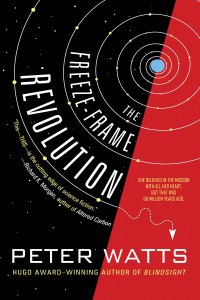Paul Di Filippo Reviews The Freeze-Frame Revolution by Peter Watts
The Freeze-Frame Revolution, Peter Watts (Tachyon Publications 978-1-61696-252-4, $14.95, 192pp, trade paperback) June 2018
 In 2014, I concluded my Locus Online review of Peter Watts’s Echopraxia by saying, “Peter Watts is some precisely engineered hybrid of Lucius Shepard and Gregory Benford, lyrical yet hard-edged, purveyor of sleek surfaces and also the ethical and spiritual contents inside.” I am happy to report, after a torturous wait of four years, that his newest book fully displays his patented blend of heart, soul and mind. It’s a novel whose central SF novum is essential for provoking the unique states of being that its characters evince. This test–first proposed, I believe, by Theodore Sturgeon–is not one that every SF novel passes.
In 2014, I concluded my Locus Online review of Peter Watts’s Echopraxia by saying, “Peter Watts is some precisely engineered hybrid of Lucius Shepard and Gregory Benford, lyrical yet hard-edged, purveyor of sleek surfaces and also the ethical and spiritual contents inside.” I am happy to report, after a torturous wait of four years, that his newest book fully displays his patented blend of heart, soul and mind. It’s a novel whose central SF novum is essential for provoking the unique states of being that its characters evince. This test–first proposed, I believe, by Theodore Sturgeon–is not one that every SF novel passes.
What we have here is a fresh riff on a motif that has seen a bit of play lately in SF. I refer to the conceit of a giant asteroid serving as a spaceship. The Science Fiction Encyclopedia entry on “Asteroids” cites an early instance of this in Murray Leinster’s The Wailing Asteroid from 1961, but I would not be surprised to learn that some half-forgotten gonzo Victorian proto-SF novel featured a version of space-rock converted into a craft. In any case, authors such as Greg Bear, Robert Reed, George Zebrowski and Kim Stanley Robinson have all done stimulating things with the notion.
Leave it to Watts to ramp up his depiction. First, his craft, the Eriphora, is powered by an active, man-made singularity in its middle, a feature which provides various gradients of gravity. And second, most consequentially, it is on a one-way mission, possibly to the Heat Death of the cosmos, and, when the story opens, has already been travelling for some sixty-five million objective years. (Here we get mild resonances to such classics as Poul Anderson’s Tau Zero and James Blish’s Cities in Flight.) The Eriphora was built in the 22nd-century on Earth by a planet struggling for survival. Its mission: to seed the Milky Way with star gates, thus opening up the territory for human use. Its crew of several thousand people exist mainly in cryonic suspension, coming awake in “tribes” only for a star gate “build.” Mostly the ship is run by a not particularly bright artificial intelligence named Chimp. Chimp’s capacities have been deliberately limited–he is the equivalent of a slightly below-average human–to ensure that he won’t creatively mess with the mission and won’t go crazy from the limitless monotony. Of course, because everything wears out, he has the capacity to create fresh iterations of himself as necessary.
Our narrator is a woman named Sunday Ahzmundin, and the story she tells will span millennia and chart a shift both in her own attitudes and in the mission and potentials of the ship.
Sunday starts out being complacent, even a tad gung-ho about their endless voyage. After all, she was raised from childhood for this fate. Why should she worry? Whatever the state of humanity back on Earth, the ship’s crew has no way of knowing, and no contact with home has ever occurred through the gates. (Sometimes, though, alien monsters emerge spontaneously when a gate is booted.) So why not enjoy the simulated recreational realities provided onboard, the carnal pleasures of being awake, and do a good job and mostly sleep your way across cosmological eras.
But Lian, her desperate friend, has had enough, and wishes an end to the mission. For that purpose she and others propose a revolution against Chimp. But how to defeat an entity that sees, hears and controls your entire environment–including the option of whether to wake one up from suspension or just keep that person on ice forever?
Eventually Sunday gets onboard with Lian’s program, and the rest of the novel is a thrilling, technologically inventive cat-and-mouse game between humans and Chimp. One might think of it as The Moon Is a Harsh Mistress turned inside out, on the plane of computer-human interactions. The ending pulls the rug out from under a lot of prior assumptions, and is satisfyingly non-conclusive.
Sunday’s voice–Watts’s prose–is jagged, hip, entrancing, smart, literate and funny. The secondary human characters are all individuated nicely, but the main depth is in the portrayal of Sunday and Chimp. She’s the one who talks most to the AI, and their dialogue has a nice Kubrickian quality to it. Betweentimes, Sunday delivers clever observations on society, human behavior, and the Murphy’s-Law-type constraints of the universe. “But there’s that law of Requisite Variety again. The simple can’t prophecy the complex…”
Given its restricted setting and lack of exterior events, the book could have been limited in interest or claustrophobia-inducing. But Watts captivates the reader entirely with the techno-melodrama of the rebellion (“If you followed the beam path of Graser 172…it would hit an unremarkable patch of bulkhead and bedrock… We’d tracked the Chimp to an uncharted node about four meters to the left of the bullseye…”), and the back-and-forth among the humans and between Sunday and Chimp. There is never a dull moment in this compact, philosophical, heart-rending tale, and the suspense is ever-present.
If you processed Barry Malzberg’s classic novel Galaxies through an Instagram filter set to “Christopher Nolan,” you might end up with something like The Freeze-Frame Revolution.
 While you are here, please take a moment to support Locus with a one-time or recurring donation. We rely on reader donations to keep the magazine and site going, and would like to keep the site paywall free, but WE NEED YOUR FINANCIAL SUPPORT to continue quality coverage of the science fiction and fantasy field.
While you are here, please take a moment to support Locus with a one-time or recurring donation. We rely on reader donations to keep the magazine and site going, and would like to keep the site paywall free, but WE NEED YOUR FINANCIAL SUPPORT to continue quality coverage of the science fiction and fantasy field.







